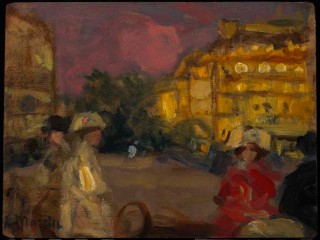
James Wilson Morrice biography
Date of birth : 1865-08-10
Date of death : 1924-01-23
Birthplace : Montreal, Canada
Nationality : Canadian
Category : Famous Figures
Last modified : 2011-07-19
Credited as : Landscape painter, ,
James Wilson Morrice was born in Montreal on Aug. 10, 1865, the son of David Morrice, a textile merchant. From 1882 to 1886 James attended the University of Toronto, and from there he went on to study law at Osgoode Hall. As a student, he began to paint landscapes in the Adirondacks and at Lake Champlain, and in 1888, while articled to a law firm, he exhibited a painting with the Royal Canadian Academy.
In 1889, with the encouragement of Sir William Van Horne, president of the Canadian Pacific Railway and a perceptive art collector, Morrice abandoned the practice of law for good and set sail for Europe. After a brief period of study at the Academie Julian in Paris, he pursued his own course with the advice of the veteran landscape painter Henri Joseph Harpignies. His associates at this time included the Americans Maurice Prendergast, Robert Henri, and William Glackens. Morrice first visited Venice about 1896, and Saint-Malo about 1900.
Every year or so Morrice returned to Canada and sketched in Quebec and Montreal, sometimes with the Canadian impressionists Maurice Cullen and William Brymner. In 1904 the French government bought Morrice's Quai des Grands Augustins, Paris and the Pennsylvania Museum of Art his The Beach, Parame. The National Gallery began to purchase his paintings in 1909.
During this period Morrice became a familiar figure in the international group of artists and writers who met at the Chat Blanc, a small restaurant in Paris. Among the group were Somerset Maugham and Arnold Bennett; the former's character Cranshaw in Of Human Bondage and the latter's Farll in Buried Alive are based in part on Morrice. In 1908 he met Henri Matisse, and they traveled in Morocco in 1911-1912 and 1912-1913, although they did not paint together.
Characteristically, Morrice made small pencil drawings or oil sketches on wooden panels no larger than 5 by 6 inches while seated in a cafe from which he could observe the passing show, a glass of whiskey at his elbow. He painted all his large pictures in his studio on the Quai des Grands Augustins, in broad areas of harmonious color and with detail kept to the minimum.
Morrice remained in France for much of World War I and was commissioned to paint the Canadian troops in action in Picardy in 1918. From 1919 on, his health began to decline, and he spent more time in warmer climates, visiting the West Indies in 1920-1921. He died while on a visit to Tunis on Jan. 23, 1924.
















